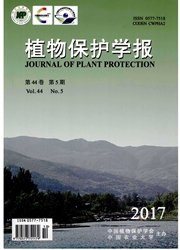

 中文摘要:
中文摘要:
嗜卷书虱Liposcelis bostrychophila Badonnel是一种发生在储粮环境中的重要害虫,其抗性问题十分突出。在实验室条件下,采用高CO2(35%CO2、21%O2、44%N2)、低O2+高CO2(35%C02、1%O2、64%N2)、DDVP和PH3等4种不同的处理,对嗜卷书虱连续处理20代,每代处理2次,每次处理保持对成虫死亡率35%的选择压力,得到了4个不同的抗性品系HCO2-R、HCLO-R、DDVP-R和PH3-R,抗性指数分别为3.3、5.2、10.2和4.5。经过对抗性发展趋势的分析,嗜卷书虱对这几种环境胁迫都有一定的抗性潜力。对抗性品系的现实遗传力(h^2)进行分析,其h^2分别为0.388、0.155、0.341和0.594。抗性风险评估结果表明,分别采用高CO2低O2+高CO2、DDVP和PH,处理,在50%的选择压力下,抗性增加10倍所需的代数分别为62.30、44.17、26.46和38.48代;而在90%的选择压力下,抗性增加lO倍所需的代数分别为28.1l、20.08、11.98和17.39代。因此对于采用气调处理,嗜卷书虱对低O2+高CO2处理的抗性风险比用高CO2处理大,而采用药剂处理,嗜卷书虱对DDVP的抗性风险要比PH3处理大。
 英文摘要:
英文摘要:
The book louse, Liposcelis bostrychophila Badonnel, is an important stored insect pest. The key issue is the development of resistance to insecticides and controlled atmospheres. In order to assess the risk of resistance of Liposcelis bostrychophila to controlled atmospheres (CAs) and insecticides, the booklice were exposed to the conditions with high concentration of carbon dioxide (hypercarbia: 35% CO2,21% 02, 44% N2), low oxygen and high carbon dioxide (hypoxia with hypercarbia: 35% CO2, 1% O2, 64% N2 ), and insecticides ( DDVP and PH3 ) respectively for 20 generations at the selection pressure of 35% adult mortality, twice selection for per generation. After 2 years' (2000 - 2001 ) selection, four resistant strains ( R), HCO2-R tolerant to hypercarbia, HCLO-R tolerant to hypoxia and hypercarbia, DDVP-R and PH3-R resistant to DDVP and PH3, were obtained in laboratory. The resistance factor (RF) values were 3.3, 5.2, 4.5 and 10.2, respectively. Analytical results of the developing strand about the different resistance strains showed that L bostrychophila had genetic potential to develop resistance. The h^2 of the 4 resistant strains,HCO2-R,HCLO-R,DDVP-R and PH3-R were 0.388, 0.155, 0.341 and 0. 594, respectively. The results of risk assessment of resistance showed, to achieve 10-fold resistance at the selection pressure of 50% and 90% mortality, it takes 62.30 and 28.10 generations for hypercarbia-exposure, 44.17 and 20.08 generations for hypoxia with hypercarbia-exposure, 26.46 and 11.98 generations for DDVP-exposure, and 38.48 and 17.39 generations for PH3-exposure, respectively. For the two CA-exposure strains, the resistance risk of HCLO-R was higher than HCO2-R ; for the two insecticide-resistant strains, the resistance risk of DDVP-R was much higher.
 同期刊论文项目
同期刊论文项目
 同项目期刊论文
同项目期刊论文
 Molecular cloning and sequence analysis of a novel P450 gene encoding CYP345D3 from the red flour be
Molecular cloning and sequence analysis of a novel P450 gene encoding CYP345D3 from the red flour be Toxicological and biochemical characterizations of GSTs in Liposcelis bostrychophila Badonnel (Psoco
Toxicological and biochemical characterizations of GSTs in Liposcelis bostrychophila Badonnel (Psoco Development and Reproduction of the Psocid Liposcelis tricolor (Psocoptera: Liposcelididae) as a Fun
Development and Reproduction of the Psocid Liposcelis tricolor (Psocoptera: Liposcelididae) as a Fun Comparison of Acetylcholinesterase from Three Geographic Populations of Liposcelis paeta Pearman (Ps
Comparison of Acetylcholinesterase from Three Geographic Populations of Liposcelis paeta Pearman (Ps Development, Survival, and Reproduction of the Psocid Liposcelis decolor (Psocoptera: Liposcelididae
Development, Survival, and Reproduction of the Psocid Liposcelis decolor (Psocoptera: Liposcelididae Temperature-Dependent Development and Reproduction of a Novel Stored Product Psocid, Liposcelis badi
Temperature-Dependent Development and Reproduction of a Novel Stored Product Psocid, Liposcelis badi 期刊信息
期刊信息
